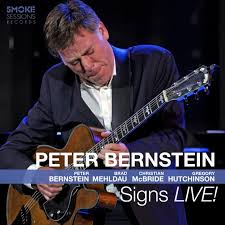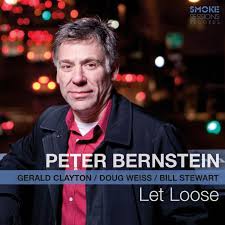Hidden Pockets – Peter Bernstein
This uptempo song doesn't have a key center. It explores both chromatic root motion and minor third key relations, all united by a relatively simple, flowing melody.
- Recording: Peter Bernstein - Signs LIVE!
- Recorded on: January 4, 2015
- Label: Smoke Sessions (SSR 1705)
- Concert Key: No key center
- Vocal Range: , to
- Style: Swing (uptempo)
- Guitar - Peter Bernstein
- Piano - Brad Mehldau
- Bass - Christian McBride
- Drums - Gregory Hutchinson
0:00
0:00
Buy MP3
Purchase Hidden Pockets - Peter Bernstein
Purchasing this song through our affiliate links with certain retailers provides jazzleadsheets.com with additional support to help keep us bringing you the best lead sheets available. Thank you!
Video
- Description
- Historical Notes
- Solos
- Piano Corner
- Bass Corner
- Drum Corner
- Guitar Corner
- Inside & Beyond
- Minus You
For more complete musical notes, please click on the next album cover (Let Loose).
This live version is faster than the studio version recorded a year later; it also lacks the rubato intro chorus. The eight-measure intro/interlude section begins the song, right on the downbeat with no pickup. The melody in the last two measures of the B section is different from the later studio recording. Instead of ending the out melody at the end of E, this version uses the interlude yet another time as a coda, adding D♭7♯5(♯9) as the final chord.
As with the studio recording, there are two choruses of guitar/drums trading which are not preceded by an interlude. The trading form is the same, and this time it's followed by an open drum solo. Drummer Gregory Hutchinson sets up the out melody by playing the rhythmic figures of the interlude.
Note: the lead sheets available under each album cover are identical.
This live version is faster than the studio version recorded a year later; it also lacks the rubato intro chorus. The eight-measure intro/interlude section begins the song, right on the downbeat with no pickup. The melody in the last two measures of the B section is different from the later studio recording. Instead of ending the out melody at the end of E, this version uses the interlude yet another time as a coda, adding D♭7♯5(♯9) as the final chord.
As with the studio recording, there are two choruses of guitar/drums trading which are not preceded by an interlude. The trading form is the same, and this time it's followed by an open drum solo. Drummer Gregory Hutchinson sets up the out melody by playing the rhythmic figures of the interlude.
Note: the lead sheets available under each album cover are identical.
Though this album was recorded almost exactly a year before "Let Loose", it was released a year after that album. The title refers to the personnel being the same as Peter's second album as a leader, "Signs Of Life", from 1994. "Signs LIVE!" contains nine Bernstein originals, all but one of which also appear on studio recordings.
Both the live and studio versions of Hidden Pockets feature the same instrumentation of guitar, piano, bass and drums. Though Peter Bernstein often adds ornamentations, specific slurs and rhythmic devices to his melodic interpretations, as you'll hear on these records, our lead sheet provides the basic melody, chord changes, hits and structure so you approach this composition either faithfully or more personally.
With a fast tempo and difficult harmonies, this tune is best suited for advanced guitarists.
With a fast tempo and difficult harmonies, this tune is best suited for advanced guitarists.
Related Songs
Email Send Hidden Pockets to a friend
Send this page to a friend via email. Add your name or email in the first field. In the second, add one or more email addresses, separated by a comma.
- Recording: Peter Bernstein - Let Loose
- Recorded on: January 31, 2016
- Label: Smoke Sessions (SSR 1604)
- Concert Key: No key center
- Vocal Range: , to
- Style: Swing (uptempo)
- Guitar - Peter Bernstein
- Piano - Gerald Clayton
- Bass - Doug Weiss
- Drums - Bill Stewart
0:00
0:00
Buy MP3
Video
- Description
- Historical Notes
- Solos
- Piano Corner
- Bass Corner
- Drum Corner
- Guitar Corner
- Inside & Beyond
- Minus You
This song has no unifying key center, but each section suggests a tonality, mostly through cleverly placed melody notes. The changes contain a lot of chromatic root motion as well as minor third key relations; the chromatic parts of the A and C sections focus on a single melody note to tie the chord qualities together.
There is an eight-measure intro with a mostly ascending melody; the changes also generally ascend, starting with G♭ major and then resolving to D, F, A♭, B, and again D major. The A section changes rise and then fall chromatically; the B section mostly continues the downward motion, introducing the first major chords of the head. E♭ major at the start of the B section leads to D♭ major, then however to B7 and E major—an interesting allusion to the minor third modulations in the intro. The C section is the same as A, and D is similar to B modulating downwards to an E section that starts in F and, like the intro, climbs both harmonically and melodically to D major.
Each section is eight measures long, and the intro reappears as an interlude before each solo. D♭7 at the end of the form leads both to G♭ major for the interlude and to C7 for the start of the next chorus.
The melody is really what holds the song together, highlighting a lot of common tones between the chords. The A and C sections have stop-time hits on the head, but this rhythm section activity is not vital to the song. It would be equally valid as a ballad; on the recording, Peter first plays the entire head rubato with piano accompaniment before launching into the intro and in head.
There is an eight-measure intro with a mostly ascending melody; the changes also generally ascend, starting with G♭ major and then resolving to D, F, A♭, B, and again D major. The A section changes rise and then fall chromatically; the B section mostly continues the downward motion, introducing the first major chords of the head. E♭ major at the start of the B section leads to D♭ major, then however to B7 and E major—an interesting allusion to the minor third modulations in the intro. The C section is the same as A, and D is similar to B modulating downwards to an E section that starts in F and, like the intro, climbs both harmonically and melodically to D major.
Each section is eight measures long, and the intro reappears as an interlude before each solo. D♭7 at the end of the form leads both to G♭ major for the interlude and to C7 for the start of the next chorus.
The melody is really what holds the song together, highlighting a lot of common tones between the chords. The A and C sections have stop-time hits on the head, but this rhythm section activity is not vital to the song. It would be equally valid as a ballad; on the recording, Peter first plays the entire head rubato with piano accompaniment before launching into the intro and in head.
The liner notes mention that this song's title comes from a poem by 13th century Persian poet Rumi. It could also refer to the song's many briefly-touched-on key centers.
Both the live and studio versions of Hidden Pockets feature the same instrumentation of guitar, piano, bass and drums. Though Peter Bernstein often adds ornamentations, specific slurs and rhythmic devices to his melodic interpretations, as you'll hear on these records, our lead sheet provides the basic melody, chord changes, hits and structure so you can approach this composition either faithfully or more personally. With a fast tempo and difficult harmonies, this tune is best suited for advanced guitarists.
Related Songs
Email Send Hidden Pockets to a friend
Send this page to a friend via email. Add your name or email in the first field. In the second, add one or more email addresses, separated by a comma.

Peter Bernstein
born on September 3, 1967
Jazz guitarist Peter Bernstein has been a part of the jazz scene in New York and abroad since 1989. During that time he has participated in over 80 recordings and numerous festival, concert and club performances with musicians from all generations. Read more...
There was a problem.
...


